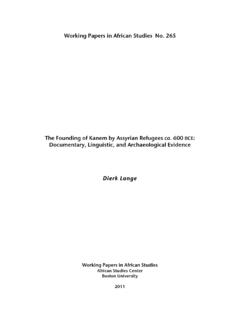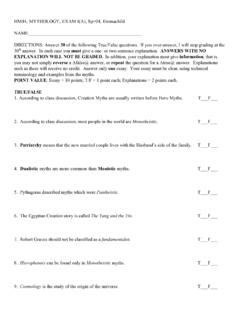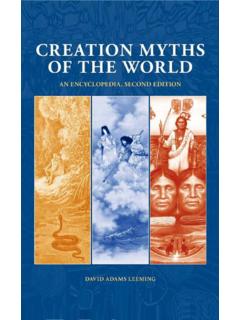Transcription of Preservation of the Canaanite Creation Culture in If
1 Preservation of the Canaanite Creation Culture in Ife1 Dierk LangeFor Africanists, the idea that cultures from the ancient Near East haveinfluenced African societies in the past in such a way that their basic fea-tures are still recognizable in the present suggests stagnation and regres-sion. Further, they associate the supposed spread of cultural patterns withwild speculations on diffusion: How can Canaan, which is often con-sidered to be the Culture of the Near East which preceeded Israel, havehad any influence on Africa? They overlook the fact that the Phoenicianswere none other than the canaanites and that as a result of their expan-sion the Canaanite Culture stretched to North Africa and to the coast ofthe Atlantic.
2 In the North African hinterland it reached at least as far asthe Fezzan, the most important group of oases in the Central of Africa pay insufficient attention to the fact that the centralSahara, similarly to the Mediterranean, with its infertile yet easily cross-able plains and its often high ground water level, was more a benefit tocommunication than a Finally, they misjudge the significanceof the diffusion process worldwide, which has been emphasized by worldhistorians like McNeill4: If Europe and Asia owe essential developmentalimpulses to ancient near eastern influences, why should not Africa aswell?My current project, however, is not an attempt to show the integrationof African peoples into ancient world history, but rather to explore the ne-1 The following study owes its main thrust to discussions with my friend and colleagueProf.
3 Biodun Adediran, Obafemi Awolowo University, Ife, in Bayreuth (winter semester2001/2002). It is further based on field research carried out within the framework of acommon project with Gabriele Weisser on royal festivals among the Hausa and Yorubafinanced by the German Research Foundation (DFG).2 Gsell 1921, II: 93-179; Ponsich 1982: 429-444; Ruprechtsberger 1997: Mauny 1961: 426-437 (trans-Saharan trade routes during the Middle Ages); 1978: 277-292 (routes during the Middle Ages); Lhote 1985: 45-62 (pre-Christian routes of the chari-ots).4 McNeill 1991: XV-XXX, 64-69, 98-100, social conditions in a particular African society for the long con-tinuity of ancient world cultural practices and institutions.
4 Perhaps thenmy title should end with a question mark. Assuming that there truly was aspread of cultural influences from the ancient Near East to parts of Westand East Africa, as much evidence would seem to suggest, is it at all con-ceivable that societies in a remote part of the oecumene, like sub-SaharanWest Africa, could preserve these cultural features for more than twothousand years?5 If so, would the Preservation of such an ancient culturalheritage demonstrate the vitality of the society concerned or its ossifi-cation and inflexibility?In searching for an answer to these questions, the Hausa, given the factthat their settlement areas begin at the southern edge of the Sahara, wouldappear a potentially valuable case study.
5 However, as over the centuriesthe influence of Islam has resulted in fundamental changes in the Hausaconcept of royalty and festivals, many aspects of the cult-centred mytho-logical tradition have been so transformed as to become is more fruitful to concentrate on the Yoruba living further south in thetropical rain forest, where Christianity, Islam and foreign ways of life on-ly became dominant about a century ago. Particularly in Ife, the religiouscenter of the Yoruba, the basic characteristics of an ancient cultural pat-tern remain clearly It is therefore in Ife that it appears mostrewarding to examine traditional kingship and cult life in terms of theconditions of their Preservation and their actual degree of a general point of view the deep rooting of the ancient cult-centered mythological pattern is the most striking observation to be madein Ife.
6 This pattern can be found in the layout of the palace, the subdivi-sion of its officials into factions, the composition of the council of judgesand in the overall order of the clans. Other aspects of the Culture of thecity are now obsolete. Although the jurisdiction of the king of Ife, theOoni, was limited to the city and a few surrounding villages, his religiousauthority was recognized by all Yoruba kingdoms and others such as5 Lange 1999a: 109-114, 156-160; 1999b: 79-81, 138-140; 2003: 1-27; Weisser 2001 The division into two cult-mythological parties, still recognizable among the Bori spir-its, can no longer be distinguished on the level of the offices of the traditionel states ( hme 2003: 97-112; Lange 2003: 7).
7 7 Frobenius 1912: 167-351; Bascom 1919: 7-12, 29-46, 77-97; Fabunmi, 1985: 1-69, 88-97; Lange 1999b: Lange126 Benin and As a token of their reverence to the Ooni, the rulers ofthese kingdoms sent pages to Ife to serve in the In return, theOoni sent the sword of Oranmiyan to coronation festivities in these otherkingdoms, by which he symbolically granted the newly-crowned kingsauthority over life and prominence of Ife, both among the Yoruba and some neighboringkingdoms, is traditionally based on the Creation myth of the world andmankind. It may sound presumptuous that the Yoruba considered the spotwhere their religious capital later arose as the birthplace of the world andthe cradle of But similar claims have been made for Babylonand In the case of Ife, however, the idea of being the birth-place of the world is not only expressed through myths, but also throughcorresponding festivals and social organizations, records for neither ofwhich exist in the aforementioned ancient This Creation Culture ,still recognizable in many spheres of Ife, has been subject to the assaultsof westernization since the beginning of the colonial era.
8 Its last remnantswill surely fall prey to the pressure of globalization in the near King and Palace of Ife as Symbols of the Creation ReligionThe Ooni stood at the center of the Creation Culture of Ife. He was aking who had little worldly power but considerable religious the kings of European history, he was much less a potentate and8 Johnson 1921: 15; Adediran 1994: Fasogbon mentions palace servants of the Emese Ilosin, who came from Oyo, Iseyin andBenin (1985: 27). In Ife heads of the deceased kings of Benin were interred at the OrunOba Ado (Willett 1967: 132). To the west, the Ife tradition is said to have reached toAbomey and Accra (Johnson 1921: 15-16; Bascom 1969: 11). 10 Having been brought to Ife after the death of his predecessor, the Ooni presented thesword to the new king at his coronation (Lokore/Obameri FN 02: 162).
9 Johnson reportsthat the new king of Oyo was given the sword of justice from Ife in the Oranmiyan shrinein Oyo (Johnson 1921: 45).11 Johnson 1921: 15 ( Creation of whites and blacks); Frobenius 1912: 285-288 (three cre-ation myths), 309 (the place of origin of all humanity, including the Europeans).12 Cf. Meissner 1925: 102-250 (Enuma elisch, IV, 137-138; VI, 33); Tully 2002: 1-252;Ps 87, For their part, the ancient Egyptians considered the Creation incomplete, and thereforebelieved that they could only guarantee the continued existence of the world through thepainstaking observance of rituals and through the careful passing down of knowledge con-cerning the cosmic connections (Assmann 1984: 685-686).
10 Canaanite Creation Culture in Ife127 Dierk Lange128 Ill. 1. The pre-colonial palace of Ife: The Ilegbo and the three ritual more a symbolic figure. Magnified by rituals and myths, he stoodcloser to the gods than to men. What distinguished him most from a secu-lar king was his seclusion in the palace. His subjects were convinced thathe neither ate nor drank, that he was married to a goddess, and that hetook part in the meetings of the As regards the king and his resi-dence, these concepts were expressed in the form of three ritual chambersand an oracle s chamber which surrounded his residential quarters, theinner Ilegbo. The three ritual chambers were dedicated to the three highgods of Ife: the primal god Oduduwa, the creator god Obatala, and themediator god Oramfe, whereas the fourth chamber was intended for theIfa arrangement of the king s residence formed the spatial basis forthe organization of the palace and the state: Each of the eight high palaceofficials (Modewa) was assigned to one of the three ritual chambers, theirhierarchy depending on the mythological significance of the respectivegods they served.











